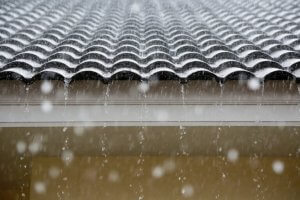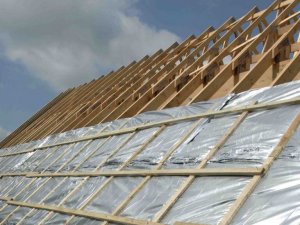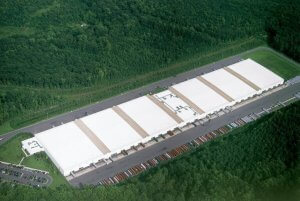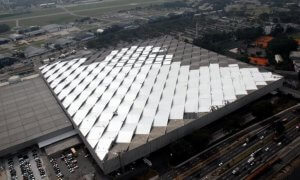Waterproof Coatings for Cool Roofs

Applying waterproof coatings to cool roofs is a common practice in industries and buildings where energy-saving is essential.
Needless to say, this waterproofing treatment has many advantages in terms of long-term building maintenance and on a day-to-day basis, helping to prevent rainwater and humidity from penetrating the building. We’ll tell you more in this article.
Cool roofs and waterproof coatings

First things first, we have to talk about cool roofs. These reflective surfaces are installed on the roofs of businesses, factories, and buildings (both public and private), where the owners are looking for ways to save as much energy as possible.
This is because reflective materials can lower temperatures throughout the entire building. This means that there’s less need to resort to air conditioning and other methods to keep buildings cool.
There are many advantages to using these kinds of roofs. For example, they stabilize the action of ultraviolet rays and have a fire retardant effect. These are just some of the reasons that cool roofs are a popular choice for factories and businesses. Some of the other main uses of cool roofs are:
- In many cases, they serve as the first layer of waterproofing. They can also be used to reinforce flat or sloping roofs, as well as balconies, rooftop terraces, and even walls and other vertical surfaces.
- To cover any imperfections that may be present on ceilings or walls.
- To improve the energy efficiency of the building, and reduce air conditioning costs.
These materials also have several other interesting advantages: they’re durable, elastic, and can cover any holes or cracks. They’re very easy to apply, highly resistant to ultraviolet rays, and free of volatile organic compounds (VOCs), making them eco-friendly. They stick well to non-porous materials with no visible joints or marks. And finally, they’re water vapor permeable while impermeable to water.
What do you need to know about waterproofing?

The waterproofing you apply to cool roofs must be excellent quality if you want it to be effective. This will also help ensure that it won’t need maintenance or urgent repairs after only a couple of months (or just the next time it rains heavily).
There are several different types of waterproofing for cool roofs. However, most experts recommend choosing a material that’s reinforced with polyester fiber to guarantee good performance on both flat and sloping roofs. It should even work well on other types of roofs.
Best of all, they can also be made in a variety of different colors, depending on your tastes. Because they’re thicker than other waterproofing materials – the standard thickness is 1.2 mm – they have a longer working life.
Another important advantage is that it can be used on both old and new buildings, regardless of whether or not they’ve already been treated with other waterproofing materials.
Before you apply waterproofing to cool roofs, you need to make sure that the product you’ve chosen meets all the requirements and certifications. This will guarantee greater durability and efficiency.
Applying waterproof coatings to cool roofs

The first thing you need to do before applying any waterproof coating is to clean the surface thoroughly. First, do a “dry clean” to clear up any dirt, dust, stains, and trash. Then do a second clean with water and detergent to remove any last traces of dirt. You’ll need to let it dry completely before you apply the waterproofing.
Next, use a palette knife to remove any peeling paint. Once you’re done, it’s best to sweep the area again to remove any dust.
When it comes to applying the waterproof coating, some people choose to use a brush around the edges of the surface, while using a roller to cover larger sections. Others use a larger tool to spread the waterproofing over the surface and cover any cracks in the ceiling.
The surface of the roof can be any color, although they’re usually gray-white to enhance the reflective properties of the coating.
People often add a layer of varnish over the waterproofing to repel any stains and dirt in the environment and the usual pollutants found in urban areas.
While applying the waterproof coating to your cool roofs, you’ll also need to incorporate high strength polyester reinforcements to prevent water absorption and delamination.
By waterproofing cool roofs, companies and factories no longer have to worry about leaks. At the same time, you should also notice a significant reduction in electricity bills, as air conditioning will no longer be a necessity in hot weather.
Applying waterproof coatings to cool roofs is a common practice in industries and buildings where energy-saving is essential.
Needless to say, this waterproofing treatment has many advantages in terms of long-term building maintenance and on a day-to-day basis, helping to prevent rainwater and humidity from penetrating the building. We’ll tell you more in this article.
Cool roofs and waterproof coatings

First things first, we have to talk about cool roofs. These reflective surfaces are installed on the roofs of businesses, factories, and buildings (both public and private), where the owners are looking for ways to save as much energy as possible.
This is because reflective materials can lower temperatures throughout the entire building. This means that there’s less need to resort to air conditioning and other methods to keep buildings cool.
There are many advantages to using these kinds of roofs. For example, they stabilize the action of ultraviolet rays and have a fire retardant effect. These are just some of the reasons that cool roofs are a popular choice for factories and businesses. Some of the other main uses of cool roofs are:
- In many cases, they serve as the first layer of waterproofing. They can also be used to reinforce flat or sloping roofs, as well as balconies, rooftop terraces, and even walls and other vertical surfaces.
- To cover any imperfections that may be present on ceilings or walls.
- To improve the energy efficiency of the building, and reduce air conditioning costs.
These materials also have several other interesting advantages: they’re durable, elastic, and can cover any holes or cracks. They’re very easy to apply, highly resistant to ultraviolet rays, and free of volatile organic compounds (VOCs), making them eco-friendly. They stick well to non-porous materials with no visible joints or marks. And finally, they’re water vapor permeable while impermeable to water.
What do you need to know about waterproofing?

The waterproofing you apply to cool roofs must be excellent quality if you want it to be effective. This will also help ensure that it won’t need maintenance or urgent repairs after only a couple of months (or just the next time it rains heavily).
There are several different types of waterproofing for cool roofs. However, most experts recommend choosing a material that’s reinforced with polyester fiber to guarantee good performance on both flat and sloping roofs. It should even work well on other types of roofs.
Best of all, they can also be made in a variety of different colors, depending on your tastes. Because they’re thicker than other waterproofing materials – the standard thickness is 1.2 mm – they have a longer working life.
Another important advantage is that it can be used on both old and new buildings, regardless of whether or not they’ve already been treated with other waterproofing materials.
Before you apply waterproofing to cool roofs, you need to make sure that the product you’ve chosen meets all the requirements and certifications. This will guarantee greater durability and efficiency.
Applying waterproof coatings to cool roofs

The first thing you need to do before applying any waterproof coating is to clean the surface thoroughly. First, do a “dry clean” to clear up any dirt, dust, stains, and trash. Then do a second clean with water and detergent to remove any last traces of dirt. You’ll need to let it dry completely before you apply the waterproofing.
Next, use a palette knife to remove any peeling paint. Once you’re done, it’s best to sweep the area again to remove any dust.
When it comes to applying the waterproof coating, some people choose to use a brush around the edges of the surface, while using a roller to cover larger sections. Others use a larger tool to spread the waterproofing over the surface and cover any cracks in the ceiling.
The surface of the roof can be any color, although they’re usually gray-white to enhance the reflective properties of the coating.
People often add a layer of varnish over the waterproofing to repel any stains and dirt in the environment and the usual pollutants found in urban areas.
While applying the waterproof coating to your cool roofs, you’ll also need to incorporate high strength polyester reinforcements to prevent water absorption and delamination.
By waterproofing cool roofs, companies and factories no longer have to worry about leaks. At the same time, you should also notice a significant reduction in electricity bills, as air conditioning will no longer be a necessity in hot weather.
All cited sources were thoroughly reviewed by our team to ensure their quality, reliability, currency, and validity. The bibliography of this article was considered reliable and of academic or scientific accuracy.
- Cruz Álvarez, J. J. (2010). Sistemas de Impermeabilización para Edificios. Revista de Arquitectura e Ingeniería.







